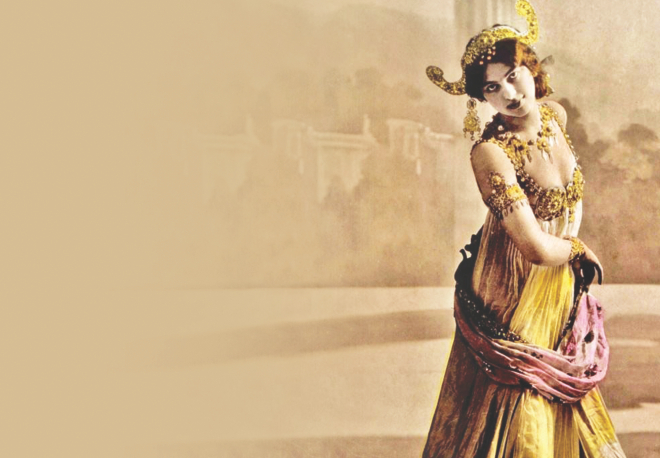MATA HARI

For most of human history, people serving in combat were overwhelmingly male. It is only recently that women are getting a more prominent role in armed forces.
But there is a long history of female involvement in espionage, even in ancient times. Espionage knows no gender and in fact being female could provide less suspicion and a better cover. There is extensive documentation of the role of women undercover and otherwise involved in intelligence work in the two world wars and some very interesting characters emerge from those two conflicts. Of them, Mata Hari is surely the most prominent. The very name of Mata Hari has become synonymous with spying, espionage, intrigue, and sensuality.
Mata Hari was born Margaretha Geertruida Zelle in Leeuwarden, Netherlands, on August 7, 1876, to father Adam Zelle, a hat merchant who went bankrupt due to bad investments, and mother Antje Zelle, who fell ill and died when Mata Hari was 15. Following her mother's death, Mata Hari and her three brothers were split up and sent to live with various relatives.
At an early age, Mata Hari decided that sexuality was her ticket in life. In the mid-1890s, she boldly answered a newspaper ad seeking a bride for Rudolf MacLeod, a bald, moustachioed military captain based in the Dutch East Indies. She sent a striking photo of herself, raven-haired and olive-skinned, to entice him. Despite a 21-year age difference, they wed on July 11, 1895, when Mata Hari was just shy of 19.
She quickly bore him two children and followed him when he was assigned to Java in 1897. The marriage proved rocky. The couple returned to the Netherlands in 1902 with their daughter (their other child, a son, had died mysteriously in Java). Margaretha's husband obtained a divorce and retained custody of his daughter.
Margaretha then made her way to Paris where she reinvented herself as an Indian temple dancer thoroughly trained in the erotic dances of the East. She took on the name Mata Hari, which means "eye of the day" in Indonesian dialect. She was soon luring audiences in the thousands as she performed in Paris, Berlin, Vienna, Madrid and other European capitals. She also attracted a number of highly-placed, aristocratic lovers willing to reward her handsomely for the pleasure of her company.
With the outbreak of World War I, Mata Hari's cross-border liaisons with German political and military figures came to the attention of the French secret police and she was placed under surveillance. Brought in for questioning, the French reportedly induced her to travel to neutral Spain in order to develop relationships with the German naval and army attaches in Madrid and report any intelligence back to Paris. In the murky world of the spy, however, the French suspected her of being a double agent. In February 1917 Mata Hari returned to Paris and was immediately arrested, charged with being a German spy. Her trial in July revealed some damning evidence that the dancer was unable to adequately explain. She was convicted and sentenced to death.
In the early-morning hours of October 15, Mata Hari was awakened and taken by car from her Paris prison cell to an army barracks on the city's outskirts where she was to meet her fate.
Dressed in a blue coat accented by a tri-corner hat, she had arrived at the execution site with a minister and two nuns and, after bidding them farewell, walked briskly to the designated spot. She dismissed her blindfold and looked the gunmen in the eye and blew them a kiss. They sent it back with bullets.
It was the end for the exotic dancer and courtesan, whose name would become a metaphor for the siren spy who coaxes secrets from her paramours.
Source: womenshistory.about.com, eyewitnesstohistory.com, biography.com


 For all latest news, follow The Daily Star's Google News channel.
For all latest news, follow The Daily Star's Google News channel. 



Comments